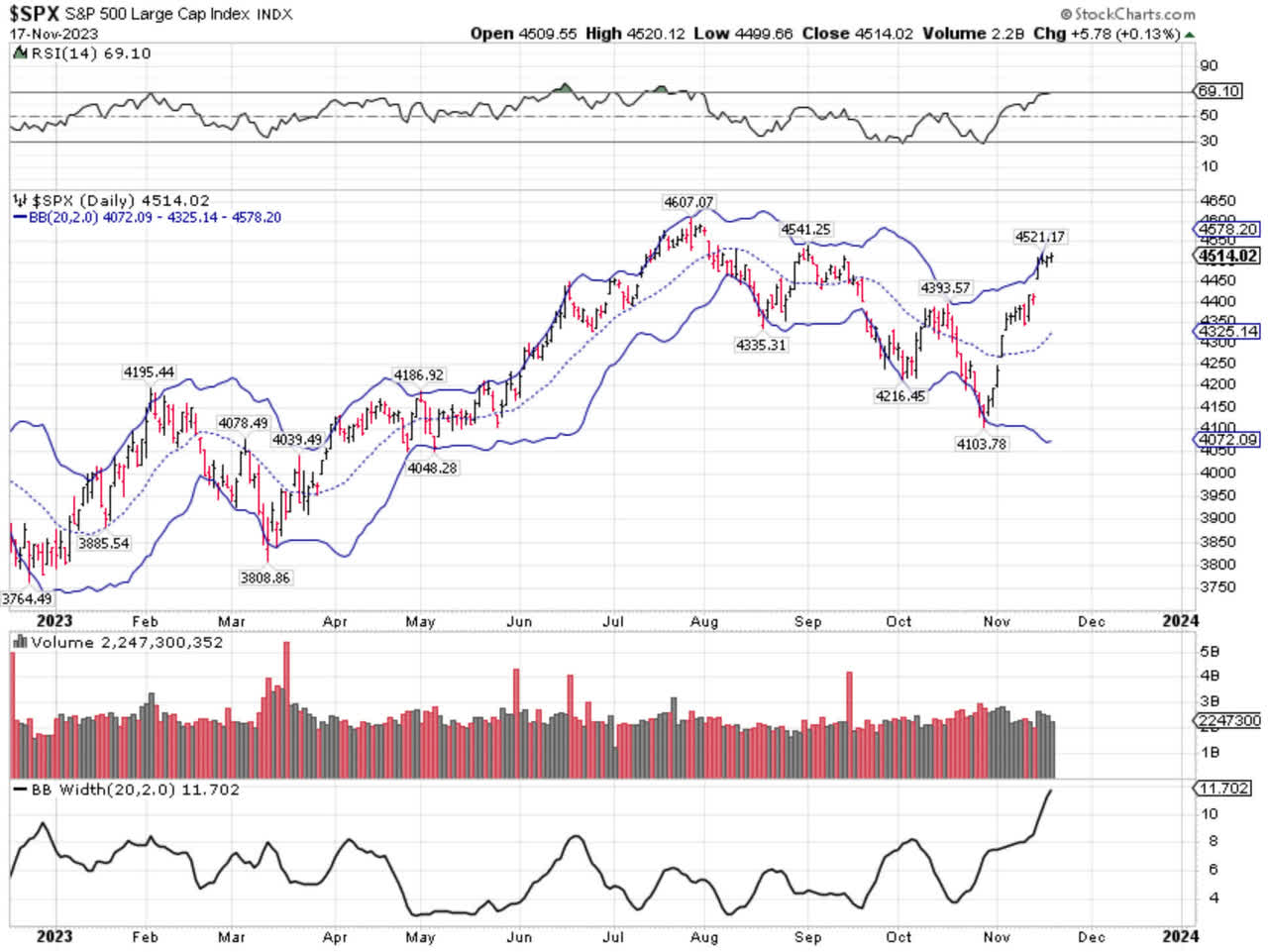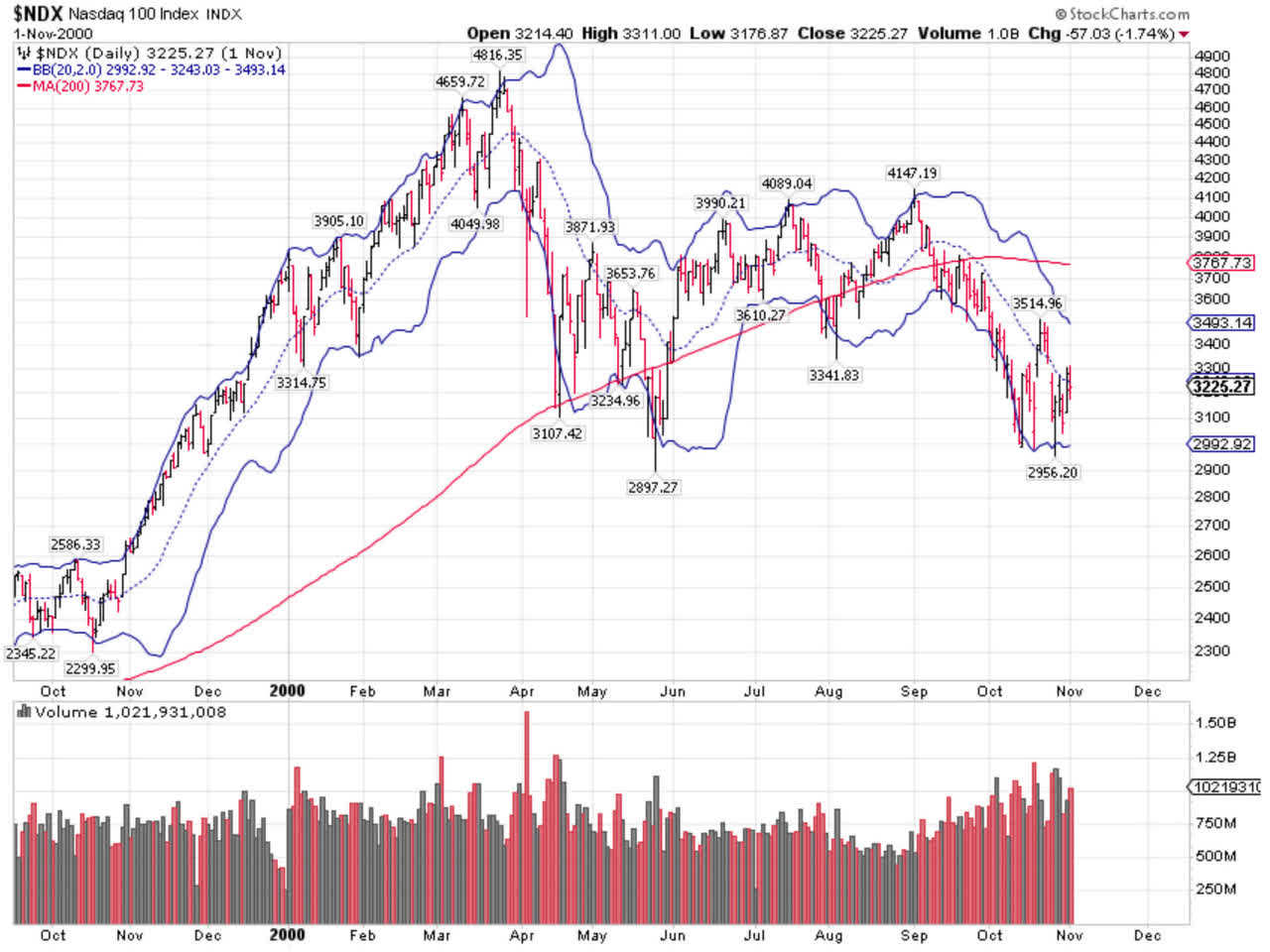The Stock Market Is Pushing Against Statistical Extremes
Summary
- Stock markets can go up a lot without a correction, but then when a correction comes, it tends to be a lot bigger than most people would like it to be.
- From a seasonal perspective, Thanksgiving week tends to be one of the most positive weeks of the year, so it should be an up week.
- In October 1999, when the NASDAQ began to rally, it did not top out until March 2000. It tagged its lower Bollinger band only once before topping out and had very shallow corrections.

Torsten Asmus
If we look at the whole year, as of last Friday, the S&P 500 is in an extreme position, based on its standard deviations away from a 20-day moving average – an indicator called Bollinger Bands, developed by John Bollinger. As of Friday, that measure is the widest (as a Bollinger Bandwidth low indicator) this year.
The upper band is two standard deviations away from the 20-day moving average – the middle line – and the lower band is two standard deviations away from the 20-day moving average to the downside.

Graphs are for illustrative and discussion purposes only. Please read important disclosures at the end of this commentary.
Tagging the upper band may mean overbought, and tagging the lower band may mean oversold, especially when the bands are wide. Being overbought, as we are today, is not a bad thing in and of itself, and staying overbought is not a bad thing either, but it does expose the stock market to headline risk.
As of this writing, there is nothing to indicate even a small correction is coming, but if you are bullish, you should be rooting for a pullback, as the market needs to breathe in and out in order for the rally to be sustainable. Stock markets can go up a lot without a correction, but then when a correction comes, it tends to be a lot bigger than most people would like it to be. In other words, you don’t want a climactic top.
From a seasonal perspective, Thanksgiving week tends to be one of the most positive weeks of the year, so it should be an up week, but that said, I would feel a lot better if we would have a couple of bad days and finished the month on a stronger note. Since the late October 2023 bottom, there have been only two down days in the S&P 500, and one of them was only marginally so – and that’s in 15 trading days.
The Most Famous Overbought Rally in Recent Memory
In October 1999, when the NASDAQ began to rally, it did not top out until March 2000 (chart below). It tagged its lower Bollinger band only once before topping out and had very shallow corrections.

Graphs are for illustrative and discussion purposes only. Please read important disclosures at the end of this commentary.
This is the type of rally we don’t want to see again. Back in 1999, breadth in the stock market was poor, and the Fed was hiking interest rates into an inverted yield curve. Sound familiar? The last rate hike in that cycle was actually in May 2000, well after the NASDAQ 100 had crashed.
I don’t know if “AI” is the new “dot.com,” but the firing of Sam Altman from OpenAI on Friday moved the market, and the investor uproar over the weekend was so loud that the OpenAI board is already begging him to take his job back. (That boardroom drama surely is not over).
I do not believe we are in such an extreme situation this time, but I sure don’t want to get into another type of dot.com bubble, even if it is called “AI” this time. The point is that the stock market can go up a lot more without a significant pullback, but that is not a healthy type of rally, as parabolic moves are prone to crashing down to earth, so if you are bullish today, I’d say you should root for a pullback.
All content above represents the opinion of Ivan Martchev of Navellier & Associates, Inc.
Disclaimer: Please click here for important disclosures located in the "About" section of the Navellier & Associates profile that accompany this article.
Disclosure: *Navellier may hold securities in one or more investment strategies offered to its clients.
Editor's Note: The summary bullets for this article were chosen by Seeking Alpha editors.
Disclaimer: Investing carries risk. This is not financial advice. The above content should not be regarded as an offer, recommendation, or solicitation on acquiring or disposing of any financial products, any associated discussions, comments, or posts by author or other users should not be considered as such either. It is solely for general information purpose only, which does not consider your own investment objectives, financial situations or needs. TTM assumes no responsibility or warranty for the accuracy and completeness of the information, investors should do their own research and may seek professional advice before investing.

